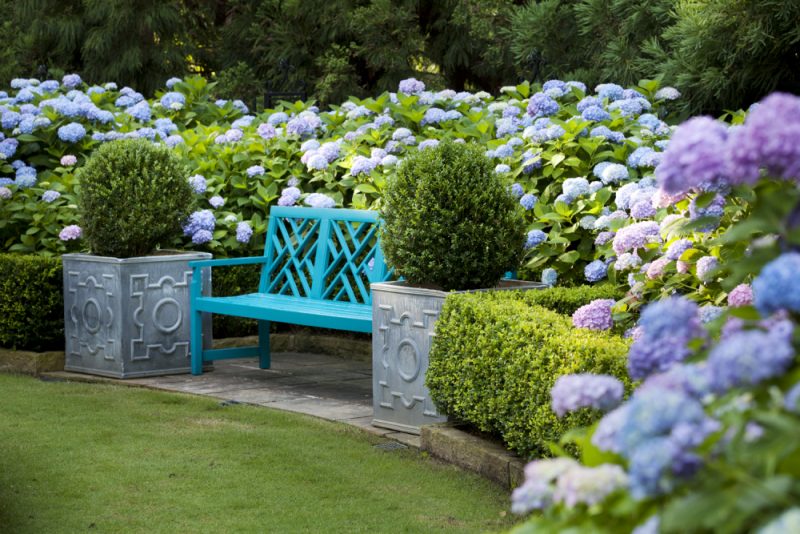Planting hydrangea garden and care have their own characteristics. To admire the beautiful and lush flowering, we learn how to properly care for this plant.
Material Content:
Hydrangea garden - types and varieties
There are many types and varieties of this ornamental shrub. Most of them prefer to grow in partial shade, but there are those that feel good in sunny areas. The height of the bushes and the flowering period are very different and depend on the variety.
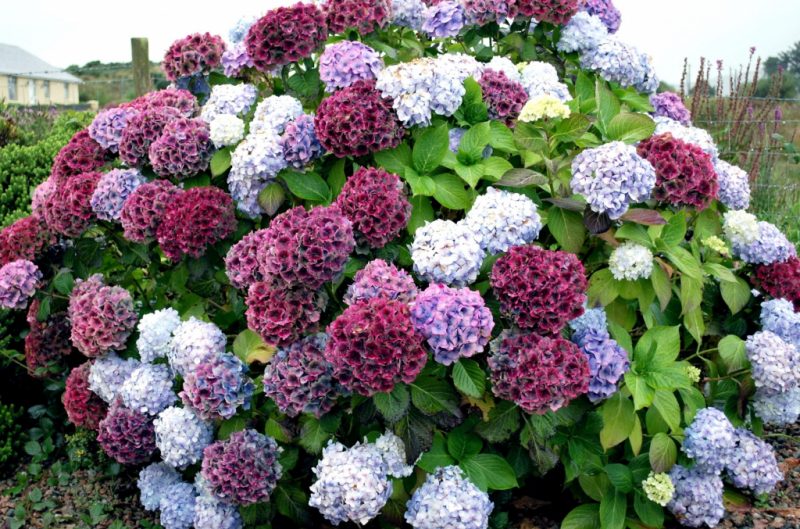
The most common types:
- Large-leaved. Blooms in the second half of summer with magnificent inflorescences in the form of balls. Flowers can have a different shade. Height - 2 m. It requires shelter in winter, the maximum tolerates temperatures up to - 10 ° C
- Petiole. A kind of creeper. Blossoms in white and pink inflorescences. It requires support, otherwise it will spread along the ground. A good option for arbors and arches.
- Tree-like. The flowers are snowy white. Height - up to 3 m. It looks very impressive, but freezes in winter. The plus is that the plant is quickly restored. Requires strong spring pruning.
- Panicled. It blooms from July to late autumn with dense panicles 30 cm long. The color of the inflorescences varies from white to greenish. The height of the bush is 3-4 m. Unpretentious and frost-resistant variety.
Based on these species, many different varieties have been created, each of which is beautiful in its own way. Depending on the type of hydrangea, they can be deciduous or evergreen, but in our area they are most often grown in the first embodiment.
Growing Features
Interestingly, the shade of inflorescences can be adjusted independently, adding certain fertilizers to the soil. On neutral soil, the flowers will have a beige or cream shade. Soil with a high alkali content gives the flowers a pink or lilac color, acids - blue.
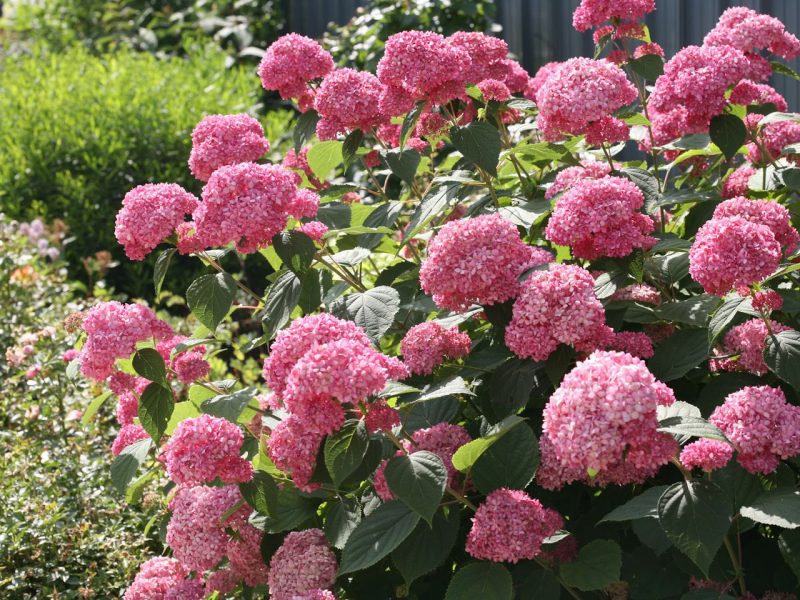
Bright shining is very important for a shrub, but the scorching sun's rays are destructive for it, as well as a deep shadow. Therefore, it is best to plant a flower where there is shade at lunchtime and the sun at other times.
It is important not to overfeed the seedlings with organics. They will build up green mass, but are unlikely to bloom.
Outdoor landing
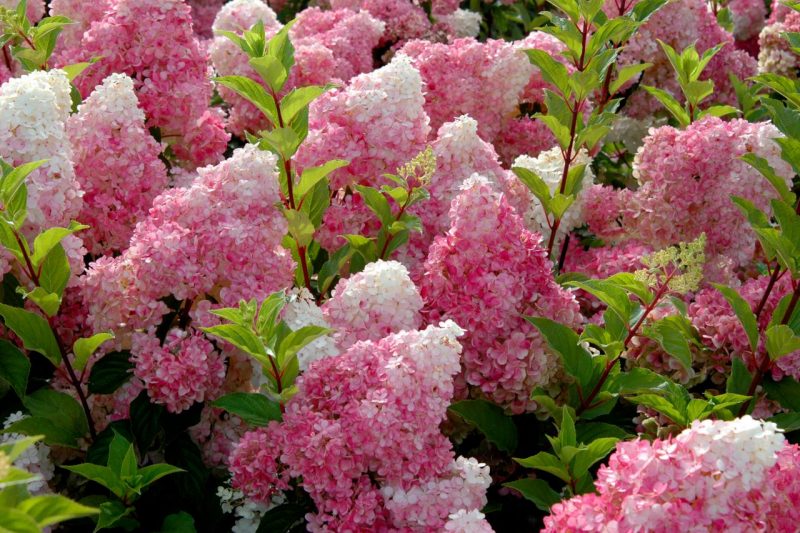
Hydrangea is a demanding flower. Therefore, before landing, you need to think through all the nuances well.
Site and soil preparation
The landing site must be prepared in advance - in about 2 weeks. The soil should be acidic and well moistened. Acidity can be adjusted independently using special drugs. Depending on the variety, flowers can grow in partial shade or in the sun. The best place to plant is light penumbra, plants will not bloom in a strong shadow.
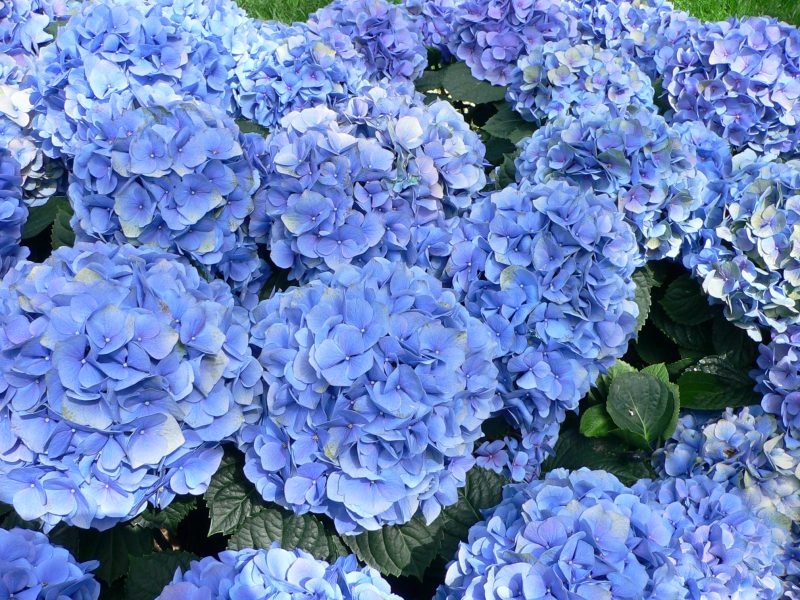
The hole should be small: 40 cm deep and 40 cm wide. If a group planting is planned, then the distance between the bushes should be at least 90-100 cm. Sand and fertilizers are added to the pit, mixing well with the ground. The next layer is poured a little peat.
How and when to plant?
Landing is done in early spring or autumn. It depends on the climate of each region. In cold areas, it is better to plant bushes in the spring so that they can give new roots, grow stronger and can survive the harsh winter. In warmer regions, landing can be done in the fall. If planting is made in the spring, then the annual shoots need to be shortened by at least 3 buds.
In a seedling, it is advisable to slightly shorten the roots. When planting, you need to ensure that the root neck is not covered by ground. The planted bush is abundantly watered and mulched with peat. When watering, you need to ensure that a strong stream of water does not erode the soil near the roots.
As soon as new leaves appear on the plant, this suggests that the process of forming new roots is in full swing.
Hydrangea Phantom Care

Hydrangea Phantom is one of the most beautiful of the panicle family. It blooms lushly throughout the season with long panicles and exudes a pleasant aroma. The variety is resistant to root diseases and frosts, quickly restored after freezing. The bush can grow in one place for many years, without requiring a transplant.
Watering and feeding
"Hydrangea" in Latin means "yearning for water." The flower is very hygrophilous, so in no case should the soil be allowed to dry out. Watering should be regular and plentiful. As soon as the topsoil dries out a little, the plant needs to be watered again. If the earth around the bush is mulled with peat, watering can be less common, as the soil does not dry out so quickly. In the first years, 7-8 liters of water are poured under each seedling, in the subsequent years - at least 18 liters.
Watering is the best time for feeding. In early spring, the plant needs nitrogen fertilizer, during the period of budding - in potassium and phosphorus.
It is useful to water the bushes with acidified water once every 2 weeks. For 10 liters of water you need to take 1 tbsp. l citric acid. The solution is poured directly under the roots. In addition, in the spring-summer period, every 3-4 weeks you need to loosen the earth in order to improve aeration.
How to transplant and crop?
The plant tolerates pruning well. If it is not cut, the bush will lose its decorative effect, and flowering will be weak. It is best to do this procedure in the spring when the kidneys swell. If the bushes are too old, they can be easily updated by cutting them almost to the root.
All types of hydrangeas can be divided into two groups:
- In the first category includes those species and varieties whose flowers are formed on the shoots of last year (petiolate, prickly, large-leaved, serrate).They do not need special pruning; it is enough to remove old, dried and incorrectly growing branches.
- In the second category includes species that form flowers on the shoots of the current year (panicled and tree-like). These bushes require strong pruning, all shoots need to be shortened in early spring to 2-3 pairs of buds.
When the hydrangea is about to bloom for the first time, it is necessary to immediately cut off all the buds so that the plant regains strength and can bloom profusely next year. Formative pruning of the bush for 5 years will help to get a beautiful small tree.
Transplant hydrangea Phantom is necessary only in extreme cases. It grows well in the same place for years. Therefore, the transplant is justified if the adult bush needs to be divided into parts and planted in other places.
Autumn flower care
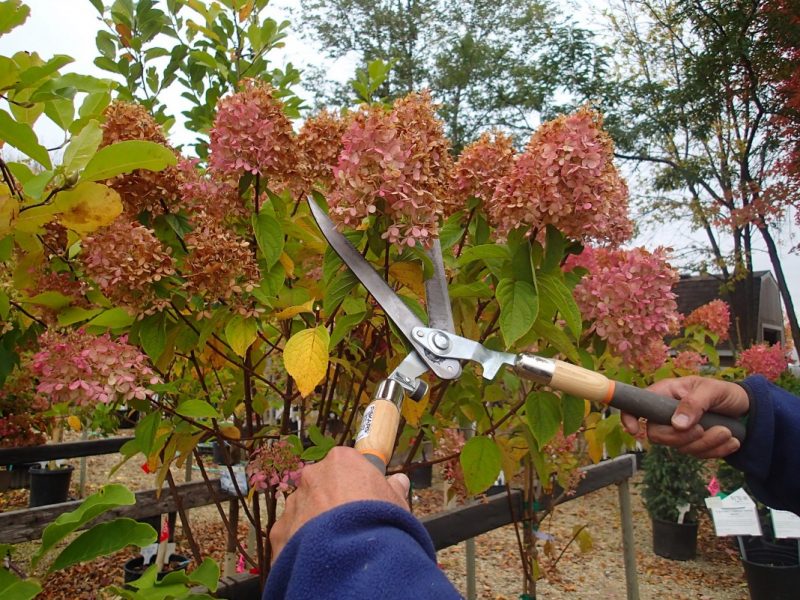
Care for hydrangea garden in the fall consists in pruning inflorescences, while at least 3 buds must be removed from the top of the shoot. This must be done so that suddenly wet snow does not freeze on them and does not break fragile branches. The base of the bushes must be high up, and the earth around them is well mulled. This will protect the superficial root system from frost.
How does hydrangea winter?
In the midland, the bush tolerates winter well. But for safety, it is still better to cover him with a spruce. In the northern regions, the flower is cleaned for a winter in a room with a plus temperature, since severe frosts can destroy it.
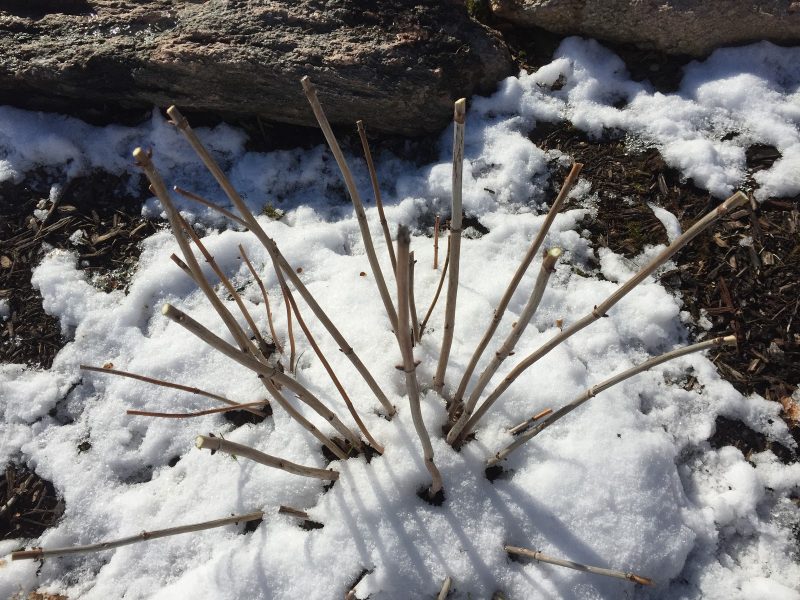
Sometimes the bushes are neatly tied, wrapped with spanbond and build a grid frame near them. The space between the covering material and the net is filled with dry foliage. With the first wave of heat, the leaves are removed, but the spanbond is removed only after a constant positive temperature is established.
How is garden hydrangea propagated?
The easiest way to propagate hydrangea cuttings. They are cut in the spring from annual green shoots. It is necessary to cut at a right angle. The length of the cuttings is not more than 12 cm. Leaves are removed from the bottom, treated with preparations to stimulate growth and planted in a greenhouse or boxes.
A good option is to propagate the flower by division. This can be done in spring and autumn. The bush is carefully dug up and divided into 3-4 parts, so that each has several buds of renewal. Billets are planted in pre-marked places.
Also, without much effort, hydrangea can be propagated by layering. Young shoots neatly bend to the ground, fix and drip with the earth, leaving the apex (about 20 cm). Already next spring or autumn, layers with roots can be separated from the mother plant and transplanted.
Sometimes the bush is propagated by seeds or grafting, but these are too laborious methods. Knowing how garden hydrangea propagates, you can pre-select the appropriate method and do it in a timely manner.
Protection against diseases and pests
Hydrangeas rarely get sick, while the lion's share of the disease is transferred with seedlings. For this reason, you need to buy new plants only in trusted nurseries. Other causes of illness are dense plantings, lack of nutrients and high humidity.

Many fungal diseases can be controlled with copper oxychloride.
One of the most common diseases is chlorosis. Due to a lack of iron, the leaves turn yellow, while the veins remain green. For treatment, Agricole, Brexil preparations are used. As a prophylaxis, plants need to be fed in a timely manner with iron-containing fertilizers.
Use in landscape design
Hydrangea looks great both in single plantings and in group ones. Just need to pre-design its location at a decent distance from other plants. Over time, the bushes grow rapidly, and they need a lot of space.
A flower can be planted as a soloist in the front garden, if it is located on the north side of the house.Choosing hydrangeas of companions in a mixborder, you need to consider their features. Similar requirements for moisture, lighting and soil acidity in astilbe, hosts, cuffs. If the site is large, you can plant a composition of several bushes. Their spreading form will create an expressive accent in the garden. Often these shrubs are used to limit garden areas.
Hydrangeas are well suited to different styles of garden design, so they can be grown by everyone.


